-
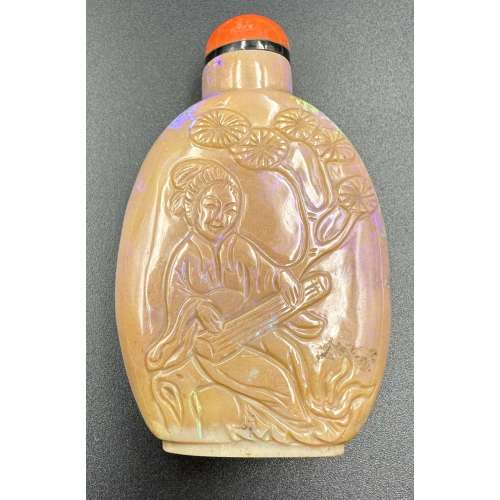 Opal jasper snuff bottle carved in low relief with a beauty playing Guqin under a pine tree and another on the veranda with a folding fan; bamboo, pine, and plum (the three friends of winter); carnelian agate stopper and black collar. Mid-20th century Dimensions: H67 x W41 x D15 mm
Opal jasper snuff bottle carved in low relief with a beauty playing Guqin under a pine tree and another on the veranda with a folding fan; bamboo, pine, and plum (the three friends of winter); carnelian agate stopper and black collar. Mid-20th century Dimensions: H67 x W41 x D15 mm -
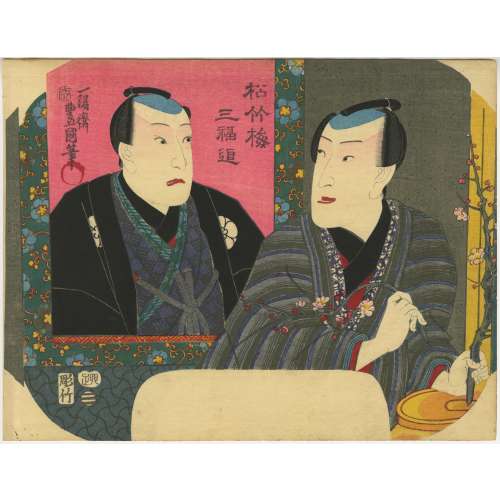 Artist: Utagawa Kunisada [歌川 国貞] a.k.a. Utagawa Toyokuni III [三代歌川豊国] (Japanese, 1786 – 1865). Signed: Ichiyōsai Toyokuni hitsu [一陽斎豊国筆]. Inscriptions: [松竹梅] Shochikubai = pine (matsu, 松), bamboo (take, 竹), and plum (ume, 梅) – an auspicious grouping known as "The Three Friends of Winter"; [三福追] (Sanpuku tsui) – the three delights, or pleasures. Date seal and aratame censor seal: Ansei 2, 1st month (1855). Publisher: Ibaya Senzaburō [伊場屋仙三郎] (Japanese, c. 1815 – 1869). Block carver: Yokokawa Takejirō [横川竹二郎] (Japanese, fl. 1845 – 1863); seal: Hori Take [彫竹]. Kabuki actor Nakamura Shikan IV [中村芝翫] (Nakamura Fukusuke I [中村福助], Nakamura Masanosuke I, Nakamura Komasaburō, Nakamura Tamatarō I, Japanese, 1831 – 1899) arranging a branch of blossoming plum to the memorial portrait of his predecessor Nakamura Utaemon IV [中村歌右衛門] (Nakamura Shikan II, Nakamura Tsurusuke I, Nakamura Tōtarō, Japanese, 1796 – 1852); the latter is dressed in a black robe adorned with a mokkō-crest (mon) of white plum blossom, the hanging scroll border decorated with arabesque and plum blossoms. Actors identified by Horst Graebner. Two fan prints from this series in Varshavsky Collection:
Artist: Utagawa Kunisada [歌川 国貞] a.k.a. Utagawa Toyokuni III [三代歌川豊国] (Japanese, 1786 – 1865). Signed: Ichiyōsai Toyokuni hitsu [一陽斎豊国筆]. Inscriptions: [松竹梅] Shochikubai = pine (matsu, 松), bamboo (take, 竹), and plum (ume, 梅) – an auspicious grouping known as "The Three Friends of Winter"; [三福追] (Sanpuku tsui) – the three delights, or pleasures. Date seal and aratame censor seal: Ansei 2, 1st month (1855). Publisher: Ibaya Senzaburō [伊場屋仙三郎] (Japanese, c. 1815 – 1869). Block carver: Yokokawa Takejirō [横川竹二郎] (Japanese, fl. 1845 – 1863); seal: Hori Take [彫竹]. Kabuki actor Nakamura Shikan IV [中村芝翫] (Nakamura Fukusuke I [中村福助], Nakamura Masanosuke I, Nakamura Komasaburō, Nakamura Tamatarō I, Japanese, 1831 – 1899) arranging a branch of blossoming plum to the memorial portrait of his predecessor Nakamura Utaemon IV [中村歌右衛門] (Nakamura Shikan II, Nakamura Tsurusuke I, Nakamura Tōtarō, Japanese, 1796 – 1852); the latter is dressed in a black robe adorned with a mokkō-crest (mon) of white plum blossom, the hanging scroll border decorated with arabesque and plum blossoms. Actors identified by Horst Graebner. Two fan prints from this series in Varshavsky Collection:
SVJP-0336.2021
-
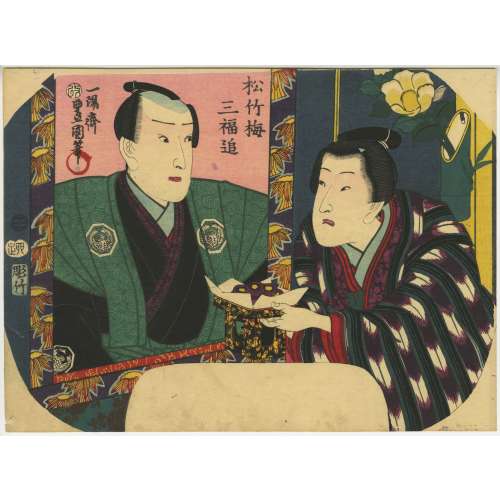 Artist: Utagawa Kunisada [歌川 国貞] a.k.a. Utagawa Toyokuni III [三代歌川豊国] (Japanese, 1786 – 1865). Signed: Ichiyōsai Toyokuni hitsu [一陽斎豊国筆]. Inscriptions: [松竹梅] Shochikubai = pine (matsu, 松), bamboo (take, 竹), and plum (ume, 梅) – an auspicious grouping known as “The Three Friends of Winter“; [三福追] (Sanpuku tsui) – the three delights, or pleasures. Date seal and aratame censor seal: Ansei 2, 1st month (1855). Publisher: Ibaya Senzaburō [伊場屋仙三郎] (Japanese, c. 1815 – 1869). Block carver: Yokokawa Takejirō [横川竹二郎] (Japanese, fl. 1845 – 1863); seal: Hori Take [彫竹]. Kabuki actor Onoe Kikugorō V [五代目尾上菊五郎] (Onoe Baikō V, Ichimura Kakitsu IV, Ichimura Uzaemon XIII, Ichimura Kurōemon, Japanese, 1844 – 1903) giving candies to the memorial portrait of his predecessor, Ichimura Takenojō V [市村竹之丞] (Ichimura Uzaemon XII, Ichimura Kamenosuke, Ichimura Toyomatsu, Japanese, 1812 – 1851); the latter is dressed in a green robe adorned with a crest (mon) of a kōrin-style crane in a tortoiseshell (octagon), the hanging scroll border decorated with bamboo under snow; the collar of Onoe's kimono decorated with plum blossoms, another plum blossom arrangement decorates the screen behind him. Actors identified by Horst Graebner. Two fan prints from this series in Varshavsky Collection:
Artist: Utagawa Kunisada [歌川 国貞] a.k.a. Utagawa Toyokuni III [三代歌川豊国] (Japanese, 1786 – 1865). Signed: Ichiyōsai Toyokuni hitsu [一陽斎豊国筆]. Inscriptions: [松竹梅] Shochikubai = pine (matsu, 松), bamboo (take, 竹), and plum (ume, 梅) – an auspicious grouping known as “The Three Friends of Winter“; [三福追] (Sanpuku tsui) – the three delights, or pleasures. Date seal and aratame censor seal: Ansei 2, 1st month (1855). Publisher: Ibaya Senzaburō [伊場屋仙三郎] (Japanese, c. 1815 – 1869). Block carver: Yokokawa Takejirō [横川竹二郎] (Japanese, fl. 1845 – 1863); seal: Hori Take [彫竹]. Kabuki actor Onoe Kikugorō V [五代目尾上菊五郎] (Onoe Baikō V, Ichimura Kakitsu IV, Ichimura Uzaemon XIII, Ichimura Kurōemon, Japanese, 1844 – 1903) giving candies to the memorial portrait of his predecessor, Ichimura Takenojō V [市村竹之丞] (Ichimura Uzaemon XII, Ichimura Kamenosuke, Ichimura Toyomatsu, Japanese, 1812 – 1851); the latter is dressed in a green robe adorned with a crest (mon) of a kōrin-style crane in a tortoiseshell (octagon), the hanging scroll border decorated with bamboo under snow; the collar of Onoe's kimono decorated with plum blossoms, another plum blossom arrangement decorates the screen behind him. Actors identified by Horst Graebner. Two fan prints from this series in Varshavsky Collection:
SVJP-0335.2021
-
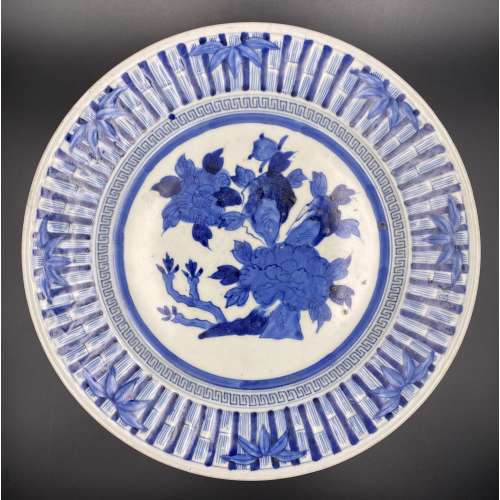 Underglaze cobalt blue and white porcelain plate decorated with a bamboo border, key fret above the blue ring, and a bush of chrysanthemums in the centre. The bottom is decorated with stylized clouds and flowers, a border of lotus petals and signed with a general mark in the centre. Diameter: 29.5 cm; Height: 3.5 cm.
Underglaze cobalt blue and white porcelain plate decorated with a bamboo border, key fret above the blue ring, and a bush of chrysanthemums in the centre. The bottom is decorated with stylized clouds and flowers, a border of lotus petals and signed with a general mark in the centre. Diameter: 29.5 cm; Height: 3.5 cm. -
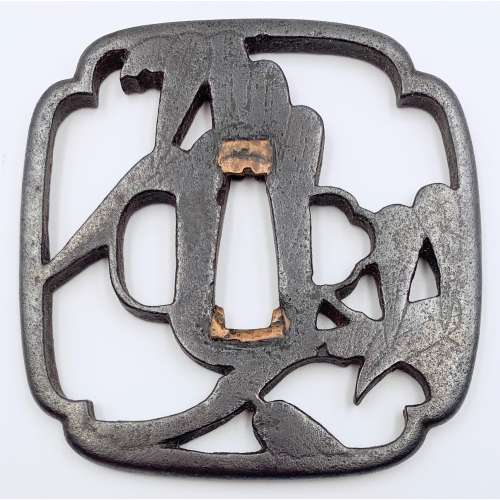 Iron tsuba of quatrefoil form with design of bamboo stems and leaves in openwork (sukashi) decorated with carving (kebori) . Copper sekigane. Early Edo period, late 17th century (Kanbun / Enppo era). First generation Kanshiro of Nishigaki school in Higo Province died in the sixth year of Genroku, 1693, at the age of 81). Height: 74.4 mm; Width: 74.2 mm; Centre thickness: 4.9 mm. Rounded rim. The design was quite popular among the Higo masters.
Iron tsuba of quatrefoil form with design of bamboo stems and leaves in openwork (sukashi) decorated with carving (kebori) . Copper sekigane. Early Edo period, late 17th century (Kanbun / Enppo era). First generation Kanshiro of Nishigaki school in Higo Province died in the sixth year of Genroku, 1693, at the age of 81). Height: 74.4 mm; Width: 74.2 mm; Centre thickness: 4.9 mm. Rounded rim. The design was quite popular among the Higo masters.
Kanshiro III, early 18th century (Sasano 1994 №267)

Matashichi I, late 17th century (Sasano 1994 №270)
The design of my tsuba closely resembles the one at the last example (Sasano 1994 №280), however, the form (mine is quatrefoil) and the execution (strength) are very different, which result in a very different spirit of my piece.
Shigemitsu II, early 18th century (Sasano 1994 №280)
-

Iron tsuba of round form pierced (sukashi) and inlaid in flat (hira-zōgan) and cast brass (suemon-zōgan), details carved in kebori, with design of two phoenixes, bamboo, and paulownia leaves and flowers (kiri-mon) on both sides. According to seller: Bizen-Yoshirō school (or Heianjō school). Unsigned.
Momoyama period. End of the 16th - beginning of the 17th century. Dimensions: Diameter: 99.5 mm; Thickness: 2.1 mm at centre; 4.3 mm at the rim. According to Merrily Baird (Symbols of Japan), "bamboo teamed with paulownia blossoms or with paulownia and the phoenix, in reference to the Chinese legend that the phoenix perches only on the paulownia and eats only the bamboo". Citation from http://www.clevelandart.org/art/1986.2.1: "The immense heraldic birds on display [...] reflect the Momoyama era's spirit of newly gained self-confidence and an affinity for grand expressive statements in painting, architecture, the textile and ceramic arts, as well as garden design. While that period preceded the arrival of prosperity, it clearly marked an extraordinary moment in Japanese cultural history, one frequently compared with the twelfth century of the Heian period. [...] Rather than an emblem of immortality, as it is in Western lore, in Japan, the phoenix evolved out of its origins in Chinese mythology to become, by the sixteenth century, an auspicious symbol of political authority. Together with clusters of the distinctively shaped paulownia leaves, this long-tailed, mythical bird [...] proclaiming an air of graceful command". -
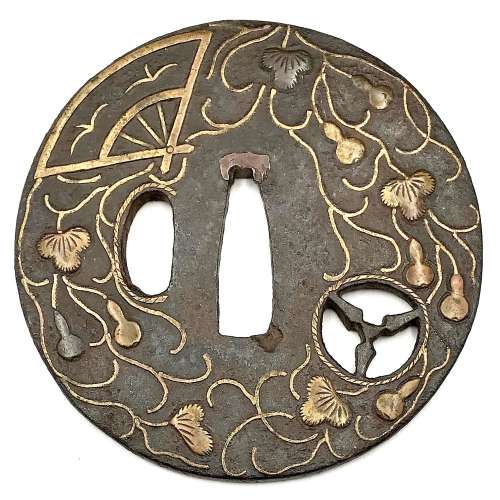
Iron tsuba of round form inlaid with brass and shakudo (suemon-zōgan) with a design of tendrils, leaves, double gourds, and folding fan with two wild geese on the face and the same design only with a fan with two interlocked rings (wachigai) on the back. Design is supplemented with a round family crest (mon) of three fans in openwork (sukashi). Hitsu-ana and the mon are outlined with brass rope. Copper sekigane.
Some attribute such tsuba as belonging to Heianjō or even Yoshirō School, and date them to Momoyama period. I keep this piece under Ōnin rubric, late Muromachi, but this is just a question of personal preference.Some inlay is missing, some repaired; traces of rust. Otherwise - decent condition.
Late Muromachi period (1514-1573). Size: 77.4 x 77.1 x 3.8 (center), 3.2 (rim) mm -
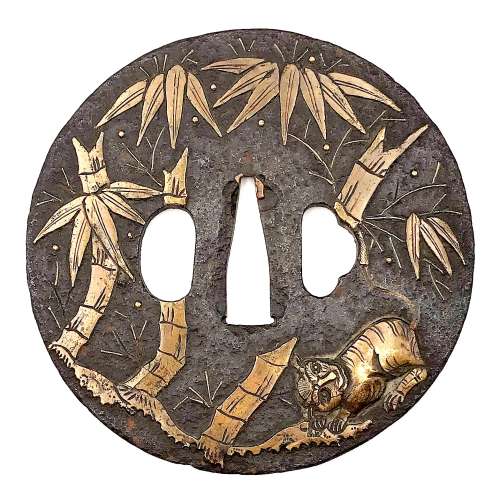 Large and thin iron tsuba of round form (width > height) decorated with the design of a tiger sheltering in bamboo in suemon-zōgan brass inlay. A fragment of tail inlay is missing. Bamboo leaves on the reverse. According to Merrily Baird [Symbols, p. 166], tiger sheltering in bamboo symbolizes "weak giving shelter to the strong". Momoyama period. Unsigned. Dimensions: 90.8 x 91.2 x 3.4 (center), 3.1 (rim) mm. Custom wooden box. NBTHK Certificate № 4001593.
Large and thin iron tsuba of round form (width > height) decorated with the design of a tiger sheltering in bamboo in suemon-zōgan brass inlay. A fragment of tail inlay is missing. Bamboo leaves on the reverse. According to Merrily Baird [Symbols, p. 166], tiger sheltering in bamboo symbolizes "weak giving shelter to the strong". Momoyama period. Unsigned. Dimensions: 90.8 x 91.2 x 3.4 (center), 3.1 (rim) mm. Custom wooden box. NBTHK Certificate № 4001593. -
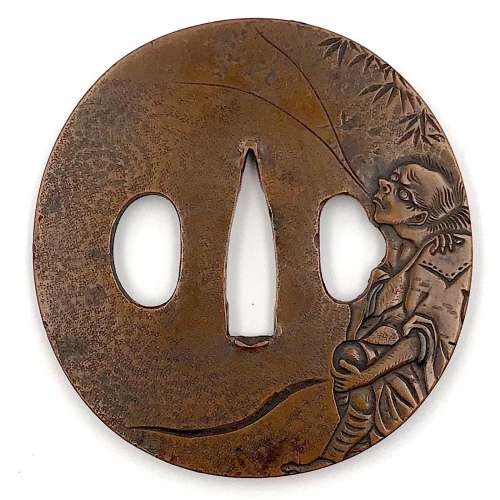
Copper tsuba of oval form carved in kebori and katakiribori with Tekkai Sennin sitting under bamboo on the face and with a pine tree on the back. Ishime-ji treated surface.
Signed on the reverse: Jōi (乗 意).
Edo period (First half of 18th century). Dimensions: 69.6 x 66.5 x 4.5 mm Sugiura Jōi (杉 浦 乗 意) was a master of Nara School in Edo; he was a student of Toshinaga [M. Sesko, 'Genealogies', p. 32]. "Sugiura Jōi (1701-1761) made many fuchigashira and kozuka, tsuba are rather rare." [M. Sesko, The Japanese toso-kinko Schools]. -
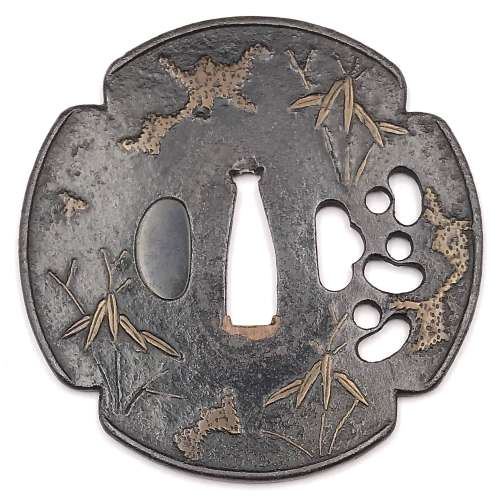 Iron tsuba of four-lobbed mokkō form (possibly it was circular and then altered to produce the mokkō) with slightly raised rim decorated with three kukurizaru ('tied up monkey' toy) in openwork (sukashi) next to kogai-hitsu-ana; inlaid in red-ish copper (suaka) with the design of bamboo stems and leaves, and shapeless masses which most probably represent snow. Kozuka-hitsu-ana plugged with shakudo. Probably original kogai-hitsu-ana. Copper sekigane. Surface still covered with lacquer (urushi). Late Muromachi period (1514-1573). Size: 86.1 x 85.8 x 2.6 mm NBTHK Certificate №4002543: Hozon - "Worthy of preservation" (Attribution: Mumei Heianjō Zōgan)
Iron tsuba of four-lobbed mokkō form (possibly it was circular and then altered to produce the mokkō) with slightly raised rim decorated with three kukurizaru ('tied up monkey' toy) in openwork (sukashi) next to kogai-hitsu-ana; inlaid in red-ish copper (suaka) with the design of bamboo stems and leaves, and shapeless masses which most probably represent snow. Kozuka-hitsu-ana plugged with shakudo. Probably original kogai-hitsu-ana. Copper sekigane. Surface still covered with lacquer (urushi). Late Muromachi period (1514-1573). Size: 86.1 x 85.8 x 2.6 mm NBTHK Certificate №4002543: Hozon - "Worthy of preservation" (Attribution: Mumei Heianjō Zōgan) -
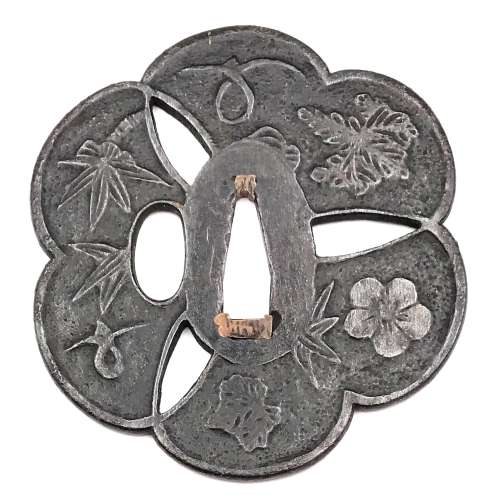 Six-lobed iron tsuba in a form of three ginkgo tree leaves (icho), separated with three small triangular openings (ko-sukashi). Leaves have raised rim and decorated with various family crests (mon) in low relief carving (sukidashi-bori). On obverse: bamboo stems and leaves, knotted geese, paulownia (kiri), plum blossom (ume), and ivy. On reverse: pine needles and cone, maple leaf (kaede), bamboo, stylized plum blossom, and Genji-mon. Black patina. Kozuka hitsu-ana is original, with raised rim. Copper sekigane. Kamakura-bori school. Late Muromachi period (ca. 1550). Size: Height: 81.1 mm. Width: 90.0 mm. Thickness at seppa-dai: 3.3 mm. Weight: 120.4 g.
Six-lobed iron tsuba in a form of three ginkgo tree leaves (icho), separated with three small triangular openings (ko-sukashi). Leaves have raised rim and decorated with various family crests (mon) in low relief carving (sukidashi-bori). On obverse: bamboo stems and leaves, knotted geese, paulownia (kiri), plum blossom (ume), and ivy. On reverse: pine needles and cone, maple leaf (kaede), bamboo, stylized plum blossom, and Genji-mon. Black patina. Kozuka hitsu-ana is original, with raised rim. Copper sekigane. Kamakura-bori school. Late Muromachi period (ca. 1550). Size: Height: 81.1 mm. Width: 90.0 mm. Thickness at seppa-dai: 3.3 mm. Weight: 120.4 g. -
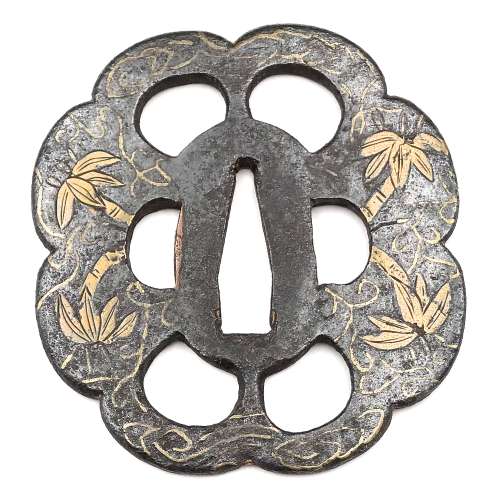 Iron tsuba of 8-lobed form pierced with six openings (sukashi) and decorated with design of bamboo and arabesque in flat brass inlay (hira-zōgan). Two of the openings serve as hitsu-ana. The design on the face represents bamboo trunks and leaves, clouds, waves, and vines; on the back - vines and leaves, that forms an arabesque (karakusa) motif. Rounded square rim. 'Silver' patina. Hitsu-ana with copper sekigane. Heianjō (most probable) or Kaga-Yoshirō school. Late Muromachi or Momoyama period; 16th century. Size: Height: 74.6 mm; Width: 69.5 mm; Thickness at seppa-dai: 4.2 mm. Weight: 113.9 g. Provenance: Gary D. Murtha. This tsuba is illustrated at: Japanese sword guards. Onin - Heianjo - Yoshiro by Gary D. Murtha [GDM Publications, 2016, p. 48]: "Iron, 80x75x3 mm tsuba with brass karakusa vines and leaves on one side with bamboo, leaves, and clouds on the reverse. This tsuba is one of those pieces that might be classified as Onin or Heianjo work, but the flush inlay tips it to the Heianjo side. Late Muromachi period." I would like to add that it easily may also be classified as Kaga-Yoshirō. Robert Haynes in Study Collection.., page 32, illustrates a look-a-like example, and writes: "This style of inlay, where the designs on the face and the back are very different, was common to the work of artists in Kyoto in the Momoyama period."
Iron tsuba of 8-lobed form pierced with six openings (sukashi) and decorated with design of bamboo and arabesque in flat brass inlay (hira-zōgan). Two of the openings serve as hitsu-ana. The design on the face represents bamboo trunks and leaves, clouds, waves, and vines; on the back - vines and leaves, that forms an arabesque (karakusa) motif. Rounded square rim. 'Silver' patina. Hitsu-ana with copper sekigane. Heianjō (most probable) or Kaga-Yoshirō school. Late Muromachi or Momoyama period; 16th century. Size: Height: 74.6 mm; Width: 69.5 mm; Thickness at seppa-dai: 4.2 mm. Weight: 113.9 g. Provenance: Gary D. Murtha. This tsuba is illustrated at: Japanese sword guards. Onin - Heianjo - Yoshiro by Gary D. Murtha [GDM Publications, 2016, p. 48]: "Iron, 80x75x3 mm tsuba with brass karakusa vines and leaves on one side with bamboo, leaves, and clouds on the reverse. This tsuba is one of those pieces that might be classified as Onin or Heianjo work, but the flush inlay tips it to the Heianjo side. Late Muromachi period." I would like to add that it easily may also be classified as Kaga-Yoshirō. Robert Haynes in Study Collection.., page 32, illustrates a look-a-like example, and writes: "This style of inlay, where the designs on the face and the back are very different, was common to the work of artists in Kyoto in the Momoyama period." -
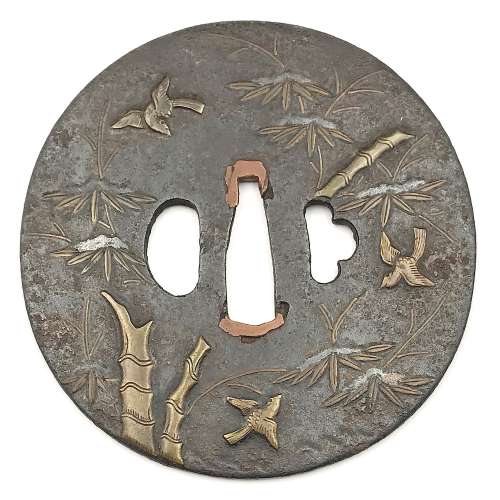 Iron tsuba decorated with sparrows and bamboo inlaid and chiseled in yellow brass, with snow lying on bamboo leaves inlaid in silver-ish shibuichi. Copper sekigane. The kogai-hitsu-ana probably cut out at a later date. Heianjō school. Unsigned. Height: 86.0 mm, Width: 85.4 mm, Thickness at seppa-dai: 2.9 mm. Momoyama or early Edo period, first half of the 17th century. Merrily Baird, Symbols..., page 118: "The association of the sparrow (suzume) with both bamboo and rice heads is an old one found in Japanese poetry, paining, and design."
Iron tsuba decorated with sparrows and bamboo inlaid and chiseled in yellow brass, with snow lying on bamboo leaves inlaid in silver-ish shibuichi. Copper sekigane. The kogai-hitsu-ana probably cut out at a later date. Heianjō school. Unsigned. Height: 86.0 mm, Width: 85.4 mm, Thickness at seppa-dai: 2.9 mm. Momoyama or early Edo period, first half of the 17th century. Merrily Baird, Symbols..., page 118: "The association of the sparrow (suzume) with both bamboo and rice heads is an old one found in Japanese poetry, paining, and design." -
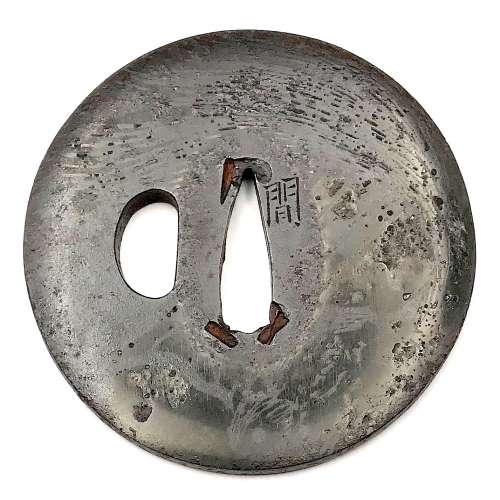 Iron tsuba of round form (width > height) decorated with a squirrel (on the face) and bamboo (on the reverse) motif in sahari flat inlay (hira-zōgan). Signed: Hazama (間) Size: 75.1mm x 75.9mm, thickness of seppa-dai 5.4mm. Early 18th century, mid Edo. Haynes/Torigoye: "There is another name for Hazama tsuba: the Kameyama school. In the period from Hōei to Kyōhō (1704-36) at Kameyama, in the province of Ise, the Kunitomo family made this style of tsuba" [...] The two artists who are best known for the sahari style of inlaid tsuba are Sadahide and Masahide" [...] The signature Hazama should be considered as that of Masahide". Sahari inlay is the distinctive characteristics of Hazama school. Sahari is an alloy of copper, tin, lead, zinc and silver. Hazama tsuba was carved patterns at first, then poured heated into the carvings on iron ground. Because it is an alloy, sahari shows different colors in each tsuba. According to Merrily Baird [Symbols, p. 163], "squirrels (risu) ... have no symbolic importance". NBTHK certificate №448388.
Iron tsuba of round form (width > height) decorated with a squirrel (on the face) and bamboo (on the reverse) motif in sahari flat inlay (hira-zōgan). Signed: Hazama (間) Size: 75.1mm x 75.9mm, thickness of seppa-dai 5.4mm. Early 18th century, mid Edo. Haynes/Torigoye: "There is another name for Hazama tsuba: the Kameyama school. In the period from Hōei to Kyōhō (1704-36) at Kameyama, in the province of Ise, the Kunitomo family made this style of tsuba" [...] The two artists who are best known for the sahari style of inlaid tsuba are Sadahide and Masahide" [...] The signature Hazama should be considered as that of Masahide". Sahari inlay is the distinctive characteristics of Hazama school. Sahari is an alloy of copper, tin, lead, zinc and silver. Hazama tsuba was carved patterns at first, then poured heated into the carvings on iron ground. Because it is an alloy, sahari shows different colors in each tsuba. According to Merrily Baird [Symbols, p. 163], "squirrels (risu) ... have no symbolic importance". NBTHK certificate №448388. -
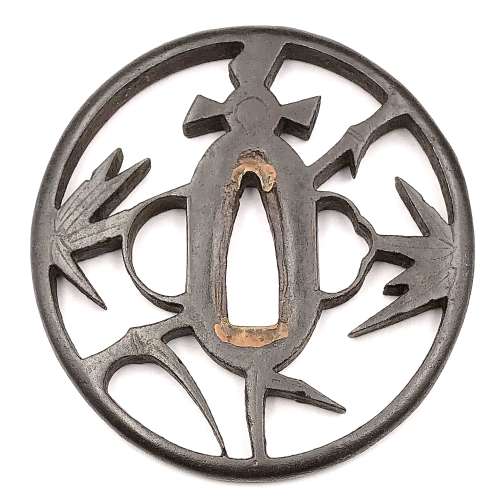 Iron tsuba with design of bamboo and sparrow (take-ni-suzume) in openwork (sukashi). Rounded rim. Copper sekigane. Akasaka school. Unsigned. Attributed to second generation Tadamasa Shōzaemon (died in in the fifth year of Enppo, 1677). Early Edo period: 17th century (Kan-ei / Kanbun era). Height: 79.0 mm. Width: 77.5 mm. Rim thickness: 5.5 mm. Center thickness: 6.6 mm. Provenance: Sasano Masayuki Collection, № 222: "It is believed that sparrows nest in a bamboo grove". According to Merrily Baird [Merrily Baird. Symbols of Japan. Thematic motifs in art and design. Rizzoli international publications, Inc., 2001], "a bamboo grove is said to be emblematic of security as the bamboo is resilient even in the face of high winds and heavy rains. [...] The association of the sparrow (suzume) with bamboo is an old one found in Japanese poetry, paining, and design. The bird is said to be obsessed with its honor, especially the repaying of debts".
Iron tsuba with design of bamboo and sparrow (take-ni-suzume) in openwork (sukashi). Rounded rim. Copper sekigane. Akasaka school. Unsigned. Attributed to second generation Tadamasa Shōzaemon (died in in the fifth year of Enppo, 1677). Early Edo period: 17th century (Kan-ei / Kanbun era). Height: 79.0 mm. Width: 77.5 mm. Rim thickness: 5.5 mm. Center thickness: 6.6 mm. Provenance: Sasano Masayuki Collection, № 222: "It is believed that sparrows nest in a bamboo grove". According to Merrily Baird [Merrily Baird. Symbols of Japan. Thematic motifs in art and design. Rizzoli international publications, Inc., 2001], "a bamboo grove is said to be emblematic of security as the bamboo is resilient even in the face of high winds and heavy rains. [...] The association of the sparrow (suzume) with bamboo is an old one found in Japanese poetry, paining, and design. The bird is said to be obsessed with its honor, especially the repaying of debts". -
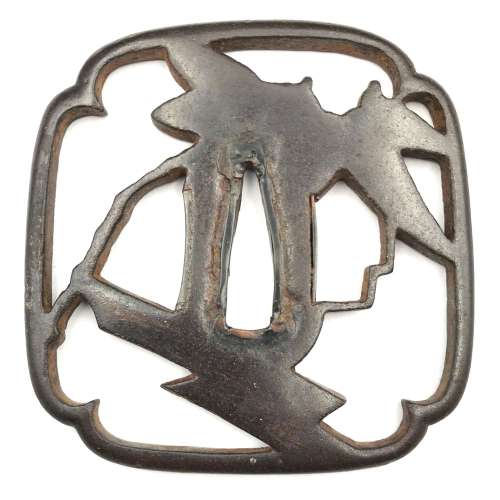 Iron tsuba of quatrefoil form with design of bamboo stems and leaves, and a plank bridge in openwork (sukashi). Hitsu-ana of irregular form. Iron with smooth chocolate patina. Copper and shakudō sekigane. This piece is illustrated in Sasano: Japanese Sword Guard Masterpieces from the Sasano Collection, 1994 on page 295 under № 254 with the following description:
Iron tsuba of quatrefoil form with design of bamboo stems and leaves, and a plank bridge in openwork (sukashi). Hitsu-ana of irregular form. Iron with smooth chocolate patina. Copper and shakudō sekigane. This piece is illustrated in Sasano: Japanese Sword Guard Masterpieces from the Sasano Collection, 1994 on page 295 under № 254 with the following description:Nishigaki. First generation Kanshiro (died in the sixth year of Genroku, 1693, at the age of 81). Sukashi design: Bamboo (take). Early Edo period, late 17th century (Kanbun / Enppo era). Height: 72.6 mm; Width: 71.5 mm; Rim thickness: .6 mm; Centre thickness: 5.1 mm. Rounded rim. The shape of this sword guard is a quatrefoil and the design is arranged in the form of a saddle flap. Two bamboo trunks with leaves comprise the design. Calm, soothing and sophisticated are the features of this artist in his later years. Such characteristics may remind one of the work of the first Hikozo.
Provenance: Sasano Masayuki collection, № 254. What is interesting, and what had been found by Bruce Kirkpatrick, is that in the earlier photograph of the same piece ['Sukashi tsuba - bushido no bi' by Sasano Masayuki, photography by Fujimoto Shihara, 1972 (in Japanese), page 245, №201] we clearly see kebori - linear carving that decorates the bamboo leaves and the planks of the bridge. The said kebori have totally disappeared between 1972 and 1994. The tsuba became absolutely flat! Now we can only speculate about the reasons for such cruel treatment of the artistically and historically important item.
Sukashi tsuba - bushido no bi. Author: Sasano Masayuki, photography: Fujimoto Shihara, 1972 (in Japanese). Page 245, №201.


